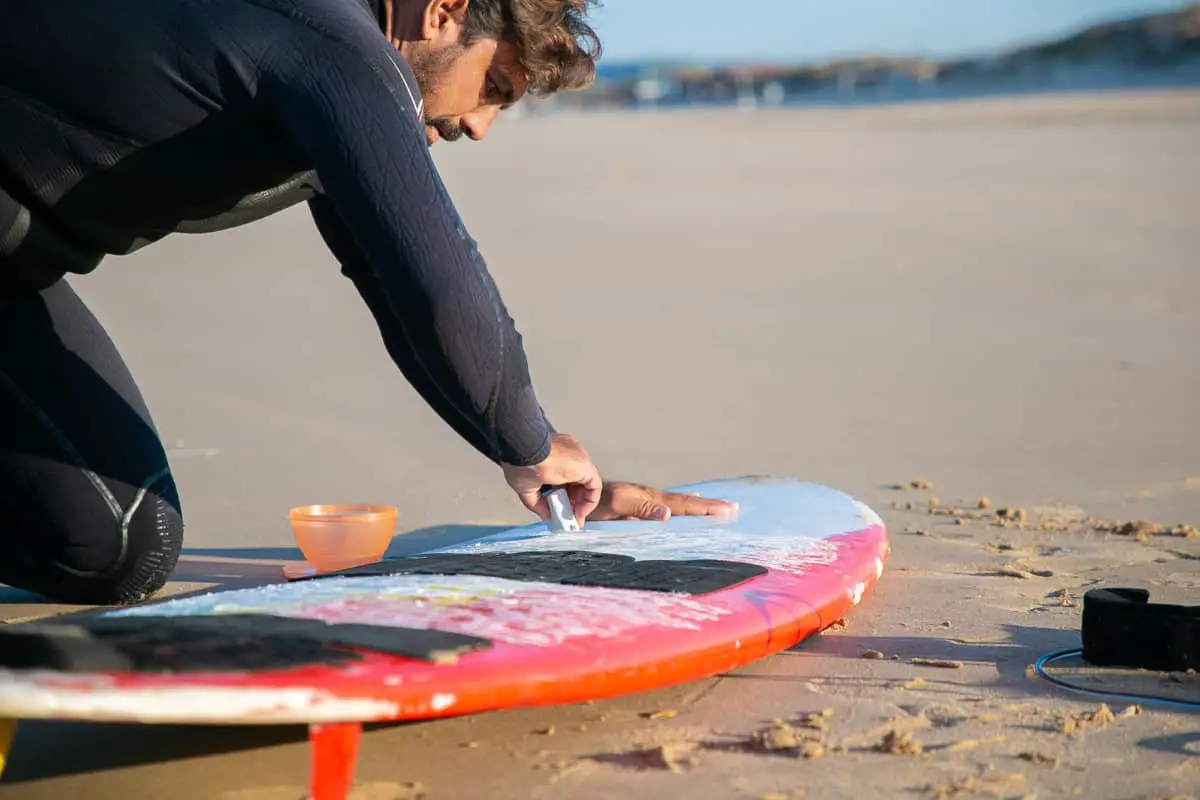There’s not much like the feeling you get taking your brand new surfboard out into the water for the first time. Even if you’ve surfed your whole life, the new board makes for an exciting day. But if you didn’t prep it, well…
To stay on your surfboard, you need to use surfboard wax. Whether your board is brand new or ages old, it needs wax on the upper surface to create the friction necessary to keep your feet in one spot. Without wax, the surface of your surfboard will become very slippery, very quickly in the water.
This article will go over the following:
- Why we use wax.
- When it’s okay not to.
- How to apply it.
- Some good wax choices.
Once you know how and why to wax your board, waxing will become a part of your surf ritual and help you carve better when you’re out on the water.
Wax Creates Friction
Most surfboards are fiberglass, which means that they are very, very smooth.
That looks nice, sure, especially on the wall in the surf shop, but having a pretty board isn’t your goal. That smoothness will make your feet slide all over the place when you’re trying to stand up.
If you’re new to surfing, you’re already having difficulty learning to balance on a moving platform that’s getting tossed about by the power of the ocean. Staying upright while sliding around on that platform? It’s a losing battle. Also, everybody uses wax.
With wax, you create a stickier, tackier surface on the board so that your feet will stick to it better.
Boards That Don’t Need Wax
The soft-top boards, also known as foamies, don’t need wax.
However, they’re not universally loved– they’re pretty polarizing. Where a “regular” surfboard has a hard, smooth, fiberglass top, the foamies have a layer on top analogous to a yoga mat– it’s softer and tackier than the fiberglass, and you don’t need wax to stick your feet to it.
Many surfers scoff at these, though. Some have good reasons, and some are just sneering at new stuff (like they once sneered at shortboards, wetsuits, and sunscreen).
Primarily thought of as boards for beginners to learn on, foamies don’t need wax, but if you start on one of them, you’ll eventually want to move to a more traditional fiberglass board as you improve on the waves. And then you’ll need some wax.
Elbow Grease and Surf Wax
Once you have your board and your wax (we’ll talk more about kinds of waxes in a bit), applying it is simple, if not physically easy. It’s not hard, but it takes some effort. It’s not like you can spray it on like paint.
On a new (or recently stripped) board, you’ll want to put some basecoat down, then move to the regular wax for the topcoat.
Follow these steps for a solid wax job that will serve you well:
- Wax in the shade, or better yet, indoors. Wax melts. Surf wax melts quicker than you think it will. If you’re waxing in the sun, the layer you’ve put down at the tail will be flaky, and the bumps you’re going to create in the steps below will not be bumpy at all. Find a shade tree first.
- Apply the basecoat. Harder wax than what you’ll use for a topcoat, basecoat wax doesn’t need to go over every square centimeter of your board. Instead, draw diagonal lines with it moving from upper left to bottom right, then upper right to bottom left. When you’re finished, the wax pattern should look like a chain-link fence.
- Add the topcoat. This stuff is softer, and you’ll use more of it. Topcoat is the stuff you use to cover the board “nose to tail and rail to rail.” Rub it on in a smooth motion, don’t go too fast, and if you start noticing that the bumps of wax you’re creating with this process are beginning to flatten, take a break because this means the friction of your rubbing motion is heating the wax, which is bad.
- Comb it. If you apply a thick coat of wax every single time you go out, or if you have lots of melt going on because you’re surfing in warm waters in the summer, your wax job will go smooth on you. Rather than strip it and start over, use a wax comb such as Outer Mountain’s Surfboard Wax Comb from Amazon.com.
This one has an edge on it you can use when it’s time to strip wax, but the bamboo teeth on the comb will help to re-roughen your wax job. Remember that the bumps and ridges of the wax are what help you get the friction you need. It’s wax, not glue, so if that wax job gets smooth, it’s useless. - Reapply topcoat. Combs won’t always do it, and most surfers add at least a touch-up coat before every venture into the water. The more you surf and learn the secrets of the water and climate where you are, the better sense you’ll get of when to reapply.
The Best Surf Wax Available
There are many brands of surf wax, but the most popular ones are popular because they work well, and surfers know they can depend on brands like Sticky Bumps and Sex Wax. Those are good, but there are other quality brands, too. Learn, then pick your poison. All of these are available on Amazon.com.
Zogs Original Sex Wax
All quality waxes are available in basecoat and have different viscosities for varying water temperatures. If you’re surfing off Baja in August, don’t get cold-water wax. Use your head.
While many surfers have been singing the praises of Sticky Bumps, I have used Sex Wax exclusively and have never had a complaint with it. I started surfing during the Reagan administration, so it’s served me well for a long time. Choose your scent and get your Sex (Wax) on.
Plus, admit it: it’s fun to say “Sex Wax.”
Sticky Bumps Surfboard Wax
It’s all there in the name.
You need sticky bumps on your board to help you stay on it, so this one is the truth in advertising. Also, Sticky Bumps comes in varying degrees of stickiness (regular, tour, and monkey, and I’ll let you decide which of those is the stickiest).
Full disclosure related to my remark about using Sex Wax above, I’ve never actually surfed with this stuff myself, but I know many surfers who left Sex Wax behind for this stuff.
Mrs. Palmer’s Surf Wax
This is another solid brand that a lot of people swear by. It’s quality enough that it’s been around a while, and it’s going to do its job of holding your feet on the board. What else is there to say? Surfers praise Mrs. Palmer’s for its staying power in warm tropical waters that cause lesser waxes to melt away.
Open Road Goods Organic Surf Wax
Since everything else in the world has an organic version, why would wax be any different?
If this is a quality you look for in a product, check out Open Road Goods’ organic solution to wax. I have never seen this stuff and don’t know anyone who uses it, but hey, some people out there want organic things in their lives, so here you go.
Conclusion
Surfing without wax on a traditional fiberglass board is a fool’s errand.
We’ve all seen brand-new surfers haul their shiny virgin boards into the water and spend the day slipping and sliding. Fun to watch, sure, but they’re not having fun.
You need wax to create friction. Without it, you can’t reliably stay on your surfboard. Fancy tricks and quick turns? Forget it if you don’t have help keeping the board under your feet. Pick up a comb, and buy wax in bulk. You will always need more.

